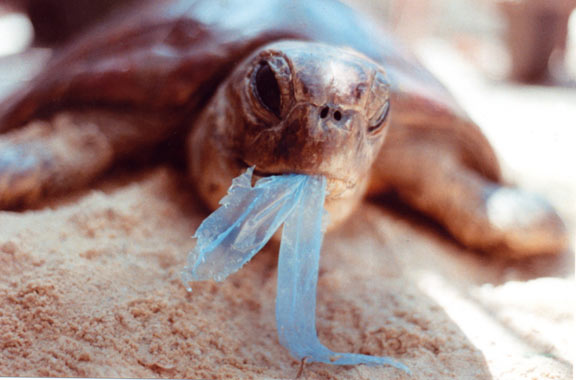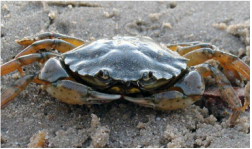Marine Impacts
Ingestion is the primary focus of research concerning the impacts of microplastics on the marine environment. Understanding which organisms are consuming microplastics and what the impact is on those organisms can clarify the significance of marine microplastic pollution. A study on mussels found that microplastic did bioaccumulate, but without significant toxicological effects. [ii] A follow-up study by P. Farrell and K. Nelson (2013) demonstrated the transfer of microplastic spheres from mussels (Mytilus edulis) to crabs (Carcinus maenas).[iii] Plankton have also been found to ingest microplastic and transfer it to higher planktonic trophic levels.[iv] Autopsied whales were also found to contain microplastic particles. It was estimated that the particle composition was 58% microsynthetic fiber in the stomach and 89% in the intestine. The polymers identified were 53% Rayon, 16% polyester, 10% acrylic, 6% polypropylene, and 4% other forms of polyethylene.[v] Another study by Lusher et al. (2013) found a similar composition of microplastics sampled from 10 fish species in the English Channel with 57.8% rayon and 35.6% polyamide.[vi]
Lastly, microsynthetic fiber particles were observed in 83% of lobsters (via trophic transfer) in the Clyde Sea; however, the study did not examine toxicological effects.[vii] These studies indicate that although microplastics may not have significant effects on certain species in the lower trophic levels, they can transfer up the food chain where the effects are poorly understood. One study by Browne et al. (2013) did find indications of significant impact by microplastic (PVC) consumption in lugworms where oxidative stress was increased by about 30%.[viii]
Microplastics have been found in multiple studies to transport persistent organic pollutants (POPs) into organisms (in particular, polyethylene/polyester).[ix],[x] A past study by Connell, R. et al (1988) also found a positive correlation between polychlorinated biphenyls (a POP) and plastic ingestion (although the plastic studied was not microscopic).[xi] The potential for microplastics to transport POPs into the food chain adds an entire category to potential impacts of microplastics as POPs have a wide array of impacts on organisms. If microplastics significantly raise the rate of POP accumulation in organisms naturally, the presence of microplastics would have complex impacts that may be quite severe. A study by Frias, J. et al. (2010) found mostly fibrous microplastic in samples of the Portuguese coast that was contaminated with POPs (including polycyclic aromatic hydrocarbon, polychlorinated biphenyls, and DDTs).[xii] Sand also provides another pathway for pollutants and a study by Brown et al. (2013) found that the amount of additives transferred by microplastic (PVC) was not significantly greater than sand.[xiii] This indicates that the pollutant transfer impacts of microplastic may be variable depending on environment.
A novel study on “small” plastic (smaller than 10 mm) found that the impacts of microplastic extended to the physical characteristics of Kamilo Beach in Hawaii. Specifically, the presence of microplastic changed the heat and water dynamics of the sand, decreasing warming rate by 16%, lowering maximum temperature (21% increase in heat capacity), and significantly increasing water permeability.[xiv]
[i] Kaposi, K. L., Mos, B., Kelaher, B. P., & Dworjanyn, S. A. (2014). Ingestion of microplastic has limited impact on a marine larva. Environmental Science & Technology, 48(3), 1638-1645.
[ii] Browne, M. A., A. Dissanayake, T.S. Galloway, D.M. Lowe, R.C. Thompson (2008). Ingested microscopic plastic translocates to the circulatory system of the mussel, Mytilus edulis(L.) Environmental Science and Technology, 42(13), pp. 5026-5031.
[iii] Farrell, P., & Nelson, K. (2013). Trophic level transfer of microplastic: Mytilus edulis (L.) to Carcinus maenas (L.). Environmental Pollution, 177, 1-3.
[iv] Setälä, O., Fleming-Lehtinen, V., & Lehtiniemi, M. (2014). Ingestion and transfer of microplastics in the planktonic food web. Environmental pollution, 185, 77-83.
[v] Lusher, A. L., Hernandez-Milian, G., O'Brien, J., Berrow, S., O'Connor, I., & Officer, R. (2015). Microplastic and macroplastic ingestion by a deep diving, oceanic cetacean: The True's beaked whale Mesoplodon mirus. Environmental Pollution, 199, 185-191.
[vi] Lusher, A. L., McHugh, M., & Thompson, R. C. (2013). Occurrence of microplastics in the gastrointestinal tract of pelagic and demersal fish from the English Channel. Marine pollution bulletin, 67(1), 94-99.
[vii] Murray, F., & Cowie, P. R. (2011). Plastic contamination in the decapod crustacean Nephrops norvegicus (Linnaeus, 1758). Marine Pollution Bulletin,62(6), 1207-1217.
[viii] Browne, M. A., Niven, S. J., Galloway, T. S., Rowland, S. J., & Thompson, R. C. (2013). Microplastic moves pollutants and additives to worms, reducing functions linked to health and biodiversity. Current Biology, 23(23), 2388-2392.
[ix] Bakir, A., Rowland, S. J., & Thompson, R. C. (2012). Competitive sorption of persistent organic pollutants onto microplastics in the marine environment. Marine pollution bulletin, 64(12), 2782-2789.
[x] Teuten, E. L., Saquing, J. M., Knappe, D. R., Barlaz, M. A., Jonsson, S., Björn, A., ... & Takada, H. (2009). Transport and release of chemicals from plastics to the environment and to wildlife. Philosophical Transactions of the Royal Society B: Biological Sciences, 364(1526), 2027-2045.
[xi] Ryan, P. G., Connell, A. D., & Gardner, B. D. (1988). Plastic ingestion and PCBs in seabirds: is there a relationship?. Marine Pollution Bulletin, 19(4), 174-176.
[xii] Frias, J. P. G. L., Sobral, P., & Ferreira, A. M. (2010). Organic pollutants in microplastics from two beaches of the Portuguese coast. Marine Pollution Bulletin, 60(11), 1988-1992.
[xiii] Browne, M. A., Niven, S. J., Galloway, T. S., Rowland, S. J., & Thompson, R. C. (2013). Microplastic moves pollutants and additives to worms, reducing functions linked to health and biodiversity. Current Biology, 23(23), 2388-2392.
[xiv] Carson, H. S., Colbert, S. L., Kaylor, M. J., & McDermid, K. J. (2011). Small plastic debris changes water movement and heat transfer through beach sediments. Marine Pollution Bulletin, 62(8), 1708-1713.
Lastly, microsynthetic fiber particles were observed in 83% of lobsters (via trophic transfer) in the Clyde Sea; however, the study did not examine toxicological effects.[vii] These studies indicate that although microplastics may not have significant effects on certain species in the lower trophic levels, they can transfer up the food chain where the effects are poorly understood. One study by Browne et al. (2013) did find indications of significant impact by microplastic (PVC) consumption in lugworms where oxidative stress was increased by about 30%.[viii]
Microplastics have been found in multiple studies to transport persistent organic pollutants (POPs) into organisms (in particular, polyethylene/polyester).[ix],[x] A past study by Connell, R. et al (1988) also found a positive correlation between polychlorinated biphenyls (a POP) and plastic ingestion (although the plastic studied was not microscopic).[xi] The potential for microplastics to transport POPs into the food chain adds an entire category to potential impacts of microplastics as POPs have a wide array of impacts on organisms. If microplastics significantly raise the rate of POP accumulation in organisms naturally, the presence of microplastics would have complex impacts that may be quite severe. A study by Frias, J. et al. (2010) found mostly fibrous microplastic in samples of the Portuguese coast that was contaminated with POPs (including polycyclic aromatic hydrocarbon, polychlorinated biphenyls, and DDTs).[xii] Sand also provides another pathway for pollutants and a study by Brown et al. (2013) found that the amount of additives transferred by microplastic (PVC) was not significantly greater than sand.[xiii] This indicates that the pollutant transfer impacts of microplastic may be variable depending on environment.
A novel study on “small” plastic (smaller than 10 mm) found that the impacts of microplastic extended to the physical characteristics of Kamilo Beach in Hawaii. Specifically, the presence of microplastic changed the heat and water dynamics of the sand, decreasing warming rate by 16%, lowering maximum temperature (21% increase in heat capacity), and significantly increasing water permeability.[xiv]
[i] Kaposi, K. L., Mos, B., Kelaher, B. P., & Dworjanyn, S. A. (2014). Ingestion of microplastic has limited impact on a marine larva. Environmental Science & Technology, 48(3), 1638-1645.
[ii] Browne, M. A., A. Dissanayake, T.S. Galloway, D.M. Lowe, R.C. Thompson (2008). Ingested microscopic plastic translocates to the circulatory system of the mussel, Mytilus edulis(L.) Environmental Science and Technology, 42(13), pp. 5026-5031.
[iii] Farrell, P., & Nelson, K. (2013). Trophic level transfer of microplastic: Mytilus edulis (L.) to Carcinus maenas (L.). Environmental Pollution, 177, 1-3.
[iv] Setälä, O., Fleming-Lehtinen, V., & Lehtiniemi, M. (2014). Ingestion and transfer of microplastics in the planktonic food web. Environmental pollution, 185, 77-83.
[v] Lusher, A. L., Hernandez-Milian, G., O'Brien, J., Berrow, S., O'Connor, I., & Officer, R. (2015). Microplastic and macroplastic ingestion by a deep diving, oceanic cetacean: The True's beaked whale Mesoplodon mirus. Environmental Pollution, 199, 185-191.
[vi] Lusher, A. L., McHugh, M., & Thompson, R. C. (2013). Occurrence of microplastics in the gastrointestinal tract of pelagic and demersal fish from the English Channel. Marine pollution bulletin, 67(1), 94-99.
[vii] Murray, F., & Cowie, P. R. (2011). Plastic contamination in the decapod crustacean Nephrops norvegicus (Linnaeus, 1758). Marine Pollution Bulletin,62(6), 1207-1217.
[viii] Browne, M. A., Niven, S. J., Galloway, T. S., Rowland, S. J., & Thompson, R. C. (2013). Microplastic moves pollutants and additives to worms, reducing functions linked to health and biodiversity. Current Biology, 23(23), 2388-2392.
[ix] Bakir, A., Rowland, S. J., & Thompson, R. C. (2012). Competitive sorption of persistent organic pollutants onto microplastics in the marine environment. Marine pollution bulletin, 64(12), 2782-2789.
[x] Teuten, E. L., Saquing, J. M., Knappe, D. R., Barlaz, M. A., Jonsson, S., Björn, A., ... & Takada, H. (2009). Transport and release of chemicals from plastics to the environment and to wildlife. Philosophical Transactions of the Royal Society B: Biological Sciences, 364(1526), 2027-2045.
[xi] Ryan, P. G., Connell, A. D., & Gardner, B. D. (1988). Plastic ingestion and PCBs in seabirds: is there a relationship?. Marine Pollution Bulletin, 19(4), 174-176.
[xii] Frias, J. P. G. L., Sobral, P., & Ferreira, A. M. (2010). Organic pollutants in microplastics from two beaches of the Portuguese coast. Marine Pollution Bulletin, 60(11), 1988-1992.
[xiii] Browne, M. A., Niven, S. J., Galloway, T. S., Rowland, S. J., & Thompson, R. C. (2013). Microplastic moves pollutants and additives to worms, reducing functions linked to health and biodiversity. Current Biology, 23(23), 2388-2392.
[xiv] Carson, H. S., Colbert, S. L., Kaylor, M. J., & McDermid, K. J. (2011). Small plastic debris changes water movement and heat transfer through beach sediments. Marine Pollution Bulletin, 62(8), 1708-1713.








